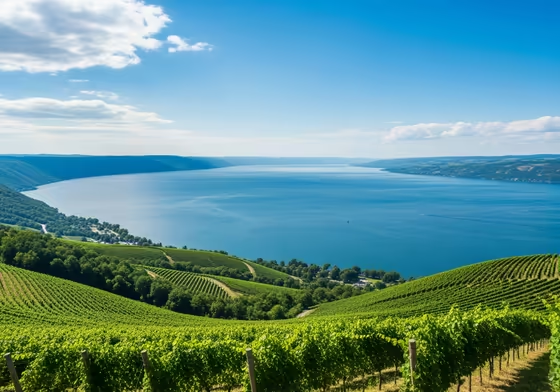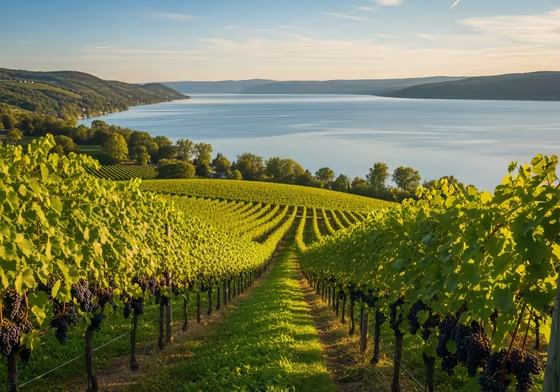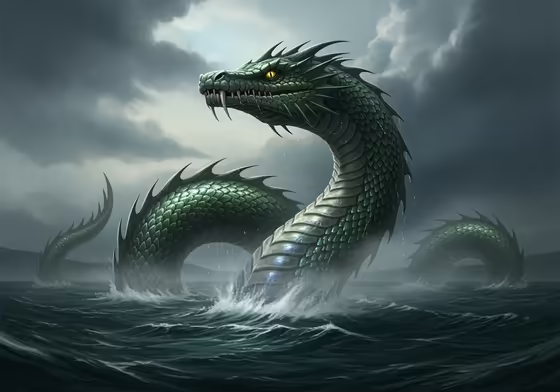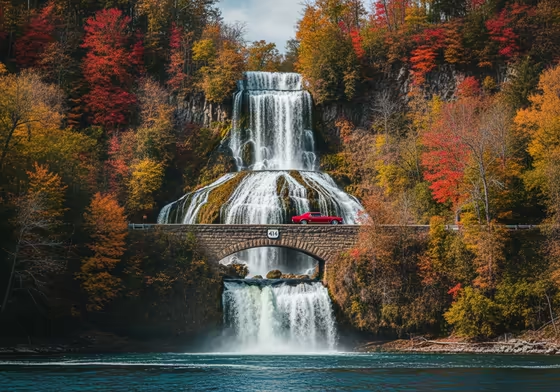A Guide to Seneca Lake
Welcome to Seneca Lake
Seneca Lake is the biggest of New York's Finger Lakes. It's the deepest and holds the most water. The lake is a big deal for the whole area, known for its beauty and its wine country.

You can find Seneca Lake right in the middle of the 11 Finger Lakes in Upstate New York. It is surrounded by four counties: Ontario, Yates, Seneca, and Schuyler.
The lake has beautiful blue water that is great for boating, fishing, and swimming. Its hills are covered in vineyards that support a huge wine industry. The lake is also home to old legends and even a modern military research base.
The Lake's Size and Unique Geology
The lake's size and shape are a big part of its story. Its geology affects everything from the weather to the local economy. The lake's depth is what makes it so special.
How Big and Deep is Seneca Lake?
Seneca Lake is huge, holding 4.2 trillion gallons of water. That's more than half of all the water in the Finger Lakes combined.
Table 1: Seneca Lake by the Numbers
| Feature | Statistic |
|---|---|
| Max. Depth | 618 feet (188 m) |
| Average Depth | 291-292 feet (89 m) |
| Length | Approx. 38 miles (61 km) |
| Max. Width | Approx. 3 miles (4.8 km) |
| Water Volume | 3.81 cubic miles / 4.2 trillion gallons |
| Shoreline | Approx. 75.4 miles (121.3 km) |
| Surface Elevation | 445-446 feet (136 m) |
The lake got so deep during the last Ice Age. Giant glaciers moved south and carved out existing river valleys, making them deeper and wider. When the glaciers melted, the valleys filled with water and became the lakes we see today.
In fact, the lake is so deep that its bottom is over 170 feet below sea level.
All that water acts like a giant radiator. It soaks up heat in the summer and slowly releases it in the fall and winter. This "lake effect" creates a special climate that protects grapevines from frost.
This climate is why the area is perfect for growing grapes used in wines like Riesling. The southeastern shore is even called the "banana belt" because it stays so warm. Because the lake holds so much heat, it almost never freezes over completely.

Why is the Water So Clear?
Seneca Lake has clear, blue water because it's an "oligotrophic" lake. This is a scientific way of saying the water is low in nutrients. With few nutrients, not much algae can grow, so the water stays very clear.
The water quality is excellent for fun activities. New York State gives it a Class AA(TS) rating, which is the highest you can get. This means the water is clean enough to be a source for drinking water and is great for swimming.
While the lake is very clean, groups like the Seneca Lake Pure Waters Association work to keep it that way. The lake gets its water from streams and underground springs. It drains out to the north through the Seneca River.
History, Legends, and a Military Secret
The human story of Seneca Lake is just as deep as its water. The story includes the Native Americans who first lived here and the strange legends about its depths. It also has a modern secret involving military technology.
The Seneca Nation and the Lake's Name
Seneca Lake is named for the Seneca Nation. They were known as the "Keepers of the Western Door" of the Haudenosaunee, or Iroquois Confederacy. This powerful group of Native American nations had a democratic government long before the United States.
Being the "Keepers of the Western Door" was an important job. The Seneca guarded the western side of their territory from outsiders.
The name "Seneca" actually came from outsiders. The Seneca people call themselves Onödowáʼga꞉, which means "Great Hill People." This name comes from their origin story near Canandaigua Lake.
The Legend of the Seneca Lake Monster

Like many deep lakes, Seneca Lake has a monster legend. The story started with Native American tales of a giant serpent in the water. In the 1800s, people started reporting sightings of a creature they called "Old Greeny."
The most famous sighting happened on July 14, 1899, on a steamship. Passengers thought they saw a boat that had flipped over. When they got closer, they saw it was a huge creature.
One passenger said it was 25 feet long with a big head and two rows of sharp, white teeth. The ship's captain reportedly ordered the crew to ram the creature. They tried to pull it on board, but it slipped away and sank into the deep water.
The Navy Base in the Middle of the Lake

If you go boating on the lake, you might see a huge barge just sitting in the middle of the water. This leads a lot of people to ask, "Do they test submarines in Seneca Lake?"
The short answer is no, they don't test the submarines themselves. They test their "ears."
That big barge belongs to the U.S. Navy. Its official name is the Naval Undersea Warfare Center. The Navy uses it to test and tune sonar equipment for its submarines.
The Navy chose Seneca Lake because it's a perfect natural laboratory. The lake is very deep, and the water temperature stays constant far below the surface. This creates a quiet environment for testing sensitive sound equipment, which is much easier and cheaper than testing in the ocean.
How to Explore the Lake
Driving Around the Lake
Driving around Seneca Lake is a great way to see the area. The full loop around the shoreline is about 78 miles long. You can drive it in about 2 to 3 hours if you don't stop.
But to really see everything, you should plan for a full day or even two. There are dozens of wineries, state parks, and small towns to check out.
The official "Seneca Lake Scenic Byway" is only a 19-mile section on the east side of the lake. This part of the drive has some of the best-known wineries and prettiest views. One cool stop is Hector Falls, where a waterfall flows under the road and into the lake.

Table 2: East Shore vs. West Shore: A Comparative Guide
| East Shore (Route 414) | West Shore (Route 14) | |
|---|---|---|
| Vibe | Relaxed and rural with lots of wineries, breweries, and places to eat. | More historic and home to some of the area's first wineries. |
| Scenery | Faces west, so you get amazing sunset views over the water. | Faces east, giving you beautiful views of the sunrise. |
| Wineries | Known as the "Banana Belt" for its warm weather. The slopes get a lot of sun, which is great for growing grapes. | Home to many well-known wineries. Some of the most famous Rieslings come from this side. |
| Best For | People who love sunsets, craft beer, and a scenic drive. | Wine lovers, history fans, and people who want a classic winery tour. |
Towns You Should Visit
Geneva (North End): This historic city is at the top of the lake. It's a hub for food, culture, and shopping.
- Belhurst Castle: A stone castle from the 1800s right on the lake. It's now a resort with a winery, brewery, spa, and two restaurants.
- Seneca Lake State Park: This park has a big beach and a popular "Sprayground" splash park for kids. It also has two marinas for boats.
Watkins Glen (South End): This town at the bottom of the lake is famous for its amazing gorge and racetrack.
-
Watkins Glen State Park Gorge Trail:
This is the most famous attraction in the Finger Lakes. The 1.5-mile trail goes down 400 feet and passes 19 waterfalls. You can even walk behind some of them, like Cavern Cascade and Rainbow Falls.
Important Visitor Note (2025-2026): The main entrance to the Watkins Glen Gorge Trail is closed for a major construction project, with an estimated completion of Summer 2026. The trail itself remains accessible via the North Rim Trail, the South and Upper entrances, or by using the park shuttle.
-
Watkins Glen International:
This is one of North America's most famous racetracks. It hosts big races, including NASCAR and sports car events.
- "Drive The Glen" Program: On certain days, you can pay to drive your own car on the racetrack behind a pace car.
Local Culture: Amish and Mennonite Communities: As you drive around, you might see horse-drawn buggies on the road. These belong to the Old Order Amish and Mennonite communities who live in the area.
- The Windmill Farm & Craft Market: This huge market is open on Saturdays in Penn Yan. It has over 175 shops, with many run by Amish and Mennonite families selling handmade furniture, food, and crafts.
- Sauder's Country Store: In Seneca Falls, this large Mennonite-run store is known for its bakery, deli, and bulk foods.
What to Do at Seneca Lake
Wine, Beer, and Spirits
The Seneca Lake Wine Trail is the biggest and busiest wine trail in New York. It has nearly 30 wineries that all focus on making wine that reflects the unique character of the lake.

The area is famous for its world-class Riesling wine. The cool climate allows the grapes to ripen slowly, giving them a perfect balance of flavor and acidity. You can find Riesling in all styles, from very dry to very sweet.
The area is also great for other drinks besides wine. Some popular spots are Wagner Valley Brewing, Two Goats Brewing, and Finger Lakes Distilling. They make great beer, whiskey, gin, and other spirits.
Getting Outside
Swimming:
Yes, you can definitely swim in Seneca Lake. The water is clean, clear, and cool. The best places to swim are the public beaches at state parks.
- Seneca Lake State Park (Geneva)
- Sampson State Park (Romulus)
- Lodi Point State Marine Park (Lodi)
- Clute Memorial Park (Watkins Glen)
Fishing:
Seneca Lake is called the "lake trout capital of the world" and hosts a big fishing tournament every year. Anglers come to catch Lake Trout, Brown Trout, Rainbow Trout, and Atlantic Salmon. You can also find Smallmouth Bass and Yellow Perch.
The state helps keep the fish population healthy. They stock the lake with trout and salmon each year. They also work to control an invasive parasite called the Sea Lamprey to protect the fish.
Boating and Paddling:
The lake is 38 miles long, which makes it great for boating. You can find good public boat launches at all the major state parks.
Table 3: Public Access & Beaches on Seneca Lake
| Name | Location | Swimming | Public Boat Launch | Boat/Kayak Rentals |
|---|---|---|---|---|
| Seneca Lake State Park | Geneva (North End) | Yes (Beach) | Yes (Hard ramp) | Yes (at Marina) |
| Sampson State Park | Romulus (East Shore) | Yes (Designated Area) | Yes (Concrete ramps) | Yes (at Marina) |
| Lodi Point State Marine Park | Lodi (East Shore) | Yes (Designated Area) | Yes (Hard ramp) | No |
| Watkins Glen | Watkins Glen (South End) | Yes (at Clute Park) | Yes (Village Marina) | Yes (nearby) |
Common Questions About Seneca Lake
How deep is Seneca Lake?
Seneca Lake is 618 feet at its deepest point. Its bottom is so deep that it's more than 170 feet below sea level.
Can you swim in Seneca Lake?
Yes. The water is very clean and safe for swimming. The best public beaches are at Seneca Lake State Park, Sampson State Park, and Clute Park. You should wear water shoes because of the rocks and sharp shells.
Why is there a Navy base on the lake?
The U.S. Navy tests sonar equipment here, not the submarines themselves. They chose Seneca Lake because it's extremely deep and has a constant water temperature. This makes it a perfect, quiet place to test sensitive sound gear.
How long does it take to drive around the lake?
The drive is about 78 miles and takes 2 to 3 hours without stopping. But you should plan for a full day or two to visit all the wineries, parks, and towns.
What's the Seneca Lake monster legend?
The most famous story is from 1899. Passengers on a boat said they saw a 25-foot creature with a big head and sharp teeth. The captain supposedly rammed the creature, but its body was never found.